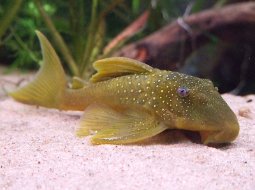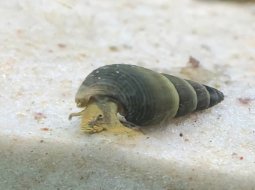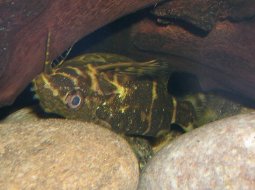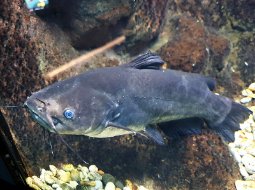
Loading Aqualapp ...
Care and Compatibility of Red-tailed Catfish - Phractocephalus hemioliopterus
Introduction
The Red-tailed Catfish, scientifically known as Phractocephalus hemioliopterus, is a freshwater fish native to South America, specifically the Amazon basin and the Orinoco River. It has an elongated and robust body, with a generally dark coloration and a striking red tail that gives it its common name. They can grow to impressive sizes, reaching over a meter in length under ideal conditions.
Behavior
The Red-tailed Catfish is a calm and nocturnal fish. During the day, they tend to hide in caves, logs, or among plants in the aquarium. They are peaceful fish that get along well with other species of similar size and calm habits. They are excellent swimmers and can move quickly when they feel threatened or when searching for food.
Sexual Dimorphism
Sexual dimorphism in Phractocephalus hemioliopterus is minimal and difficult to distinguish. Both males and females have a similar appearance.
Reproduction
Reproduction of Red-tailed Catfish in captivity is extremely rare and difficult to achieve. Information about their reproduction in the aquarium is limited. In the wild, it is believed that they migrate to flood areas during the rainy season to reproduce. Due to their size and specific reproductive needs, it is not common for them to breed in the home environment.
Aquarium Conditions
Phractocephalus hemioliopterus, commonly known as the redtail catfish, requires a large and well-filtered aquarium with plenty of space to swim and explore. It prefers neutral to slightly acidic water. Aquarium décor should include hiding spots and refuge areas. Maintaining water quality is crucial and providing a varied diet.
Feeding
The Red-tailed Catfish is a carnivorous predator and feeds primarily on small fish and crustaceans. In the aquarium, they can be offered live foods such as small fish, shrimp, or mussels. They will also accept frozen foods or high-quality pellets designed for carnivorous fish. It is important to ensure they receive adequate and varied feeding to maintain their health and vitality.
Complexity
Caring for Phractocephalus hemioliopterus can be challenging due to its large size and space and water requirements. They are predators and need a protein-rich diet. They require an aquarium large enough to grow and move comfortably. They are sensitive to water quality and may require frequent maintenance.
In case you need more help, or if you want to know into any topic related to the Phractocephalus hemioliopterus (Red-tailed Catfish) and even any other species you can use the forums to ask what you need.
To do an analysis more detailed about coexistence and behavior of Phractocephalus hemioliopterus (Red-tailed Catfish) use the Aquarium simulation tool, if you do this you can test different ways to combine the Red-tailed Catfish with other fishes giving the dimensions and space on you aquarium, on this way you can known the optimal configuration for keep the fishes that you want.
You can also find out the 14 species compatible with the Phractocephalus hemioliopterus (Red-tailed Catfish) can live together.
Note: The parameters of the water such as PH and temperature are also used to calculate the compatibility of the species.
Compatible species (14)
Compatible (2 Species)
Similar Sizes (1 Species)
They can coexist if they are the same size or very similar sizes, it does not work in all cases, there may be exceptions.
With Reservation (6 Species)
Compatible in some cases, it depends on the nature and personality of the fish.
Las especies territoriales por lo general pueden convivir con especies protegidas con coraza, ya que no pueden hacerles daño por su dura piel, lo que si hay que tener en cuenta es tener un acuario con dimensiones favorables para que cada pez pueda delimitar un territorio, ya que la mayoría de peces acorazados son también peces de fondo y les gusta estar buscando lugares donde ocultarse.
Compatible if space is enough (5 Species)
They can coexist together if the aquarium they share is large and spacious enough for both species to feel good, as some fish may attack others to feel that they have little space and try to eliminate the competition.
Red-tailed Catfish
Phractocephalus hemioliopterus
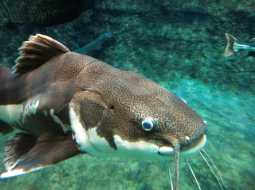
- Ph: 6 - 7.4
- Temperature (c°): 20 - 28
- Measures: 100 cm
- Aquarium Capacity:
500 Liters - 132 Gallons - Alimentación: Carnivores, Piscivore
- Colores: Black, Gris, White
- Comportamiento: Active, Peaceful, Territorial
- Habitad: American
- Morfología: Thorns or pointed
- Preferencias del Acuario: Natural plants, Rocks
- Tamaño: Very Big
- Tipo de Agua: Sweet water, Tropical waters
- Velocidad de nado o movimiento: Normal
- Zona de Nado: Aquarium background, Swim in the middle of the aquarium


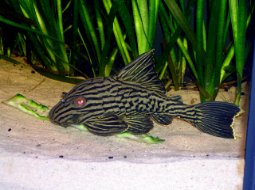
.jpg)
